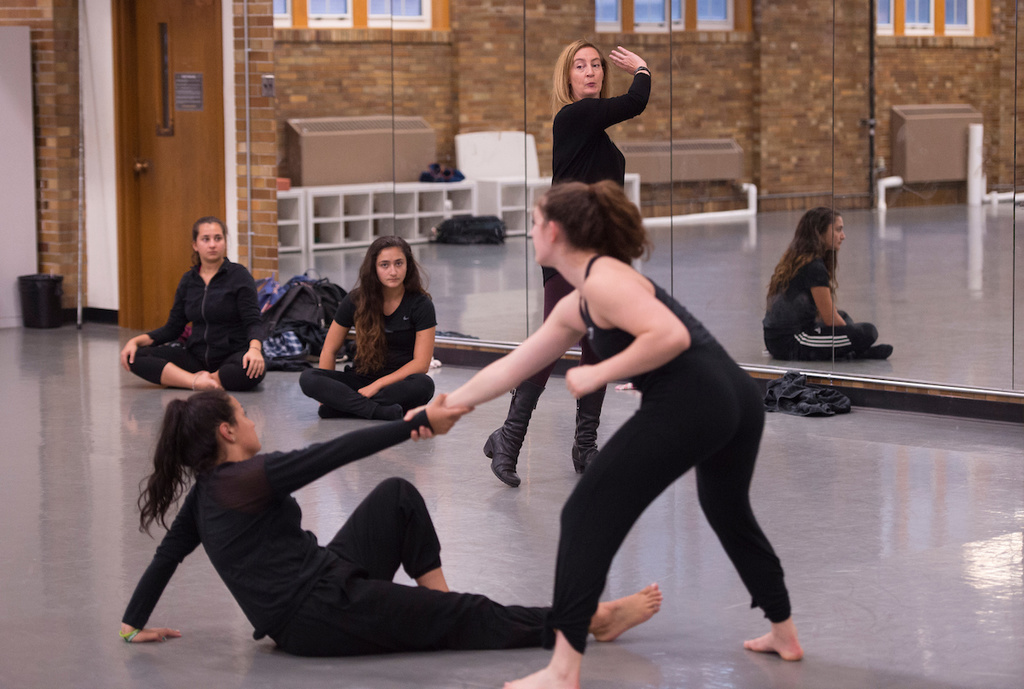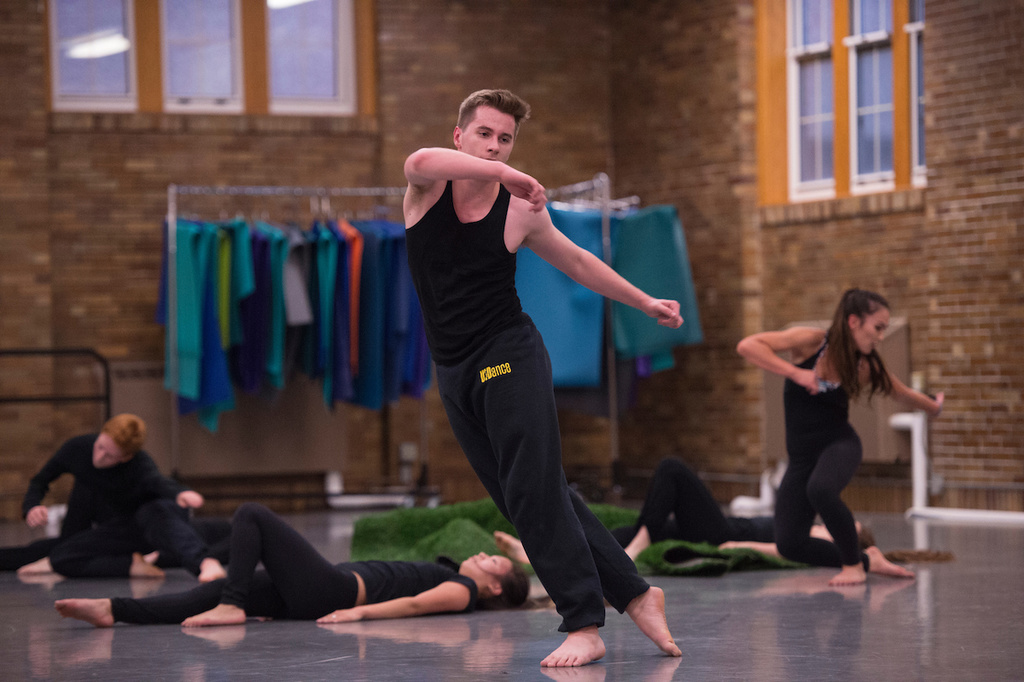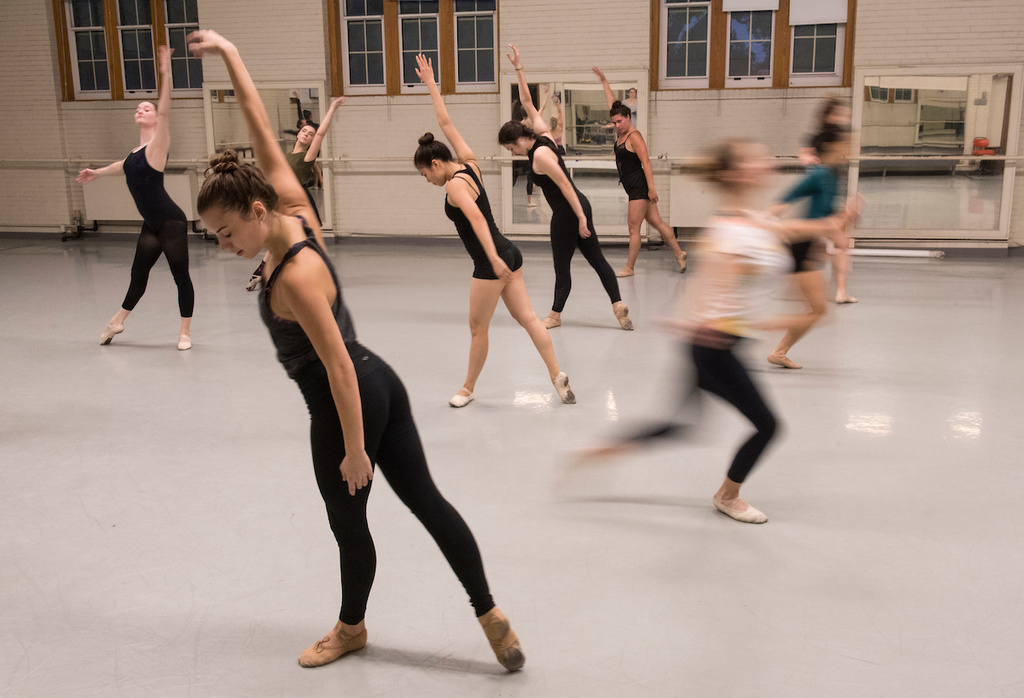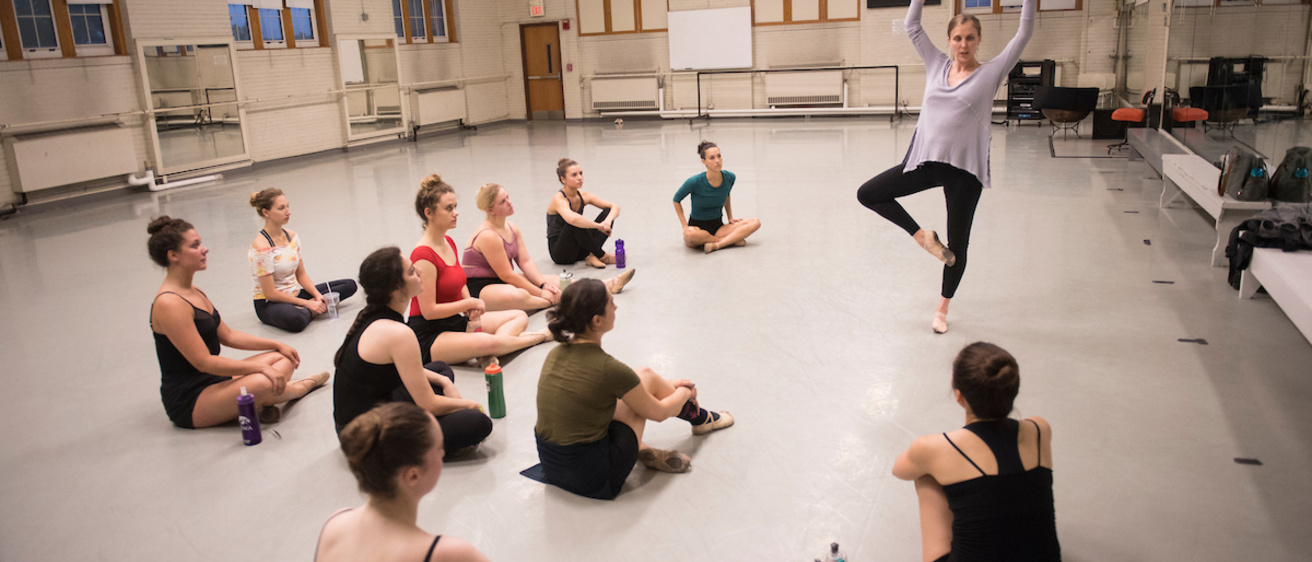There’s an old saying: Those who can, do; those who can’t, teach. While most people would agree this isn’t true, those who need to be persuaded otherwise need look no further than the University of Iowa’s Dance Gala.
The annual tradition returns Nov. 10–11 to the Hancher Auditorium stage for the first time since the 2008 flood. Along with the premiere of an original work created for Dance Gala by award-winning artist Monica Bill Barnes, the works of five members of the UI’s highly acclaimed dance faculty will be brought to life by their students.
These faculty choreographers have won awards and had their pieces performed around the world, but they’re also motivated to use their art and creativity to challenge and inspire the next generation.
“I implore people to not look at teaching as some kind of backup or default,” says Jennifer Kayle, associate professor of dance and director of the UI’s MFA dance program. “It plays such an important role in the human experience. And it’s not easy. It’s an art and science in itself.”
Rebekah Kowal, associate professor of dance and chair of the Department of Dance, says it’s important to look at the practice of dance as creative research, with continuity between the classroom and the studio.
“It’s two sides of the same coin,” Kowal says. “People think of research as only happening in a laboratory. It’s the same as a scientist putting a student to work in a lab. Our faculty are giving students first-hand experience with cutting-edge research.”

Many of UI’s choreographers were inspired, both in their art and in their teaching, by experiences with their own mentors and teachers. Kristin Marrs, a lecturer in ballet, says she was particularly inspired by the late choreographer and teacher Kennet Oberly.
“One of the most powerful pieces I did with him was set to ‘Goldberg Variations,’ by Johann Sebastian Bach, and it was a collaboration with an artist who created a large painting in real time,” Marrs says. “Kennet was extremely interested in the interrelationships of the arts. He was rooted in strong ballet technique but was adventurous and didn’t feel restricted by that tradition. He inspired me to work with different palettes.”
According to Marrs’ students, Oberly’s influence shines in her own teaching and art.
“She balances the physicality of dance with creativity,” says Lauren Vasilakos, a junior dance and biology major from the Twin Cities in Minnesota. “It’s really cool to see the interface between the two and see what we can do with it. We feel we have the freedom to express ourselves when working with her.”
Both Kayle and Marrs say their artistic process remains the same when choreographing a piece—whether it will be performed by students or professional dancers.
“We hold our students to professional standards in work ethic and technique,” Marrs says. “I don’t come in with a teaching agenda, such as getting ‘X,’ ‘Y,’ or ‘Z’ across. But it tends to come out naturally in the coaching of the movement. Because these college students are younger and less experienced, the coaching is sometimes more explicit than it would be with professionals, but not always.”
Kayle points to time as the biggest difference she faces when creating a work for students. In the professional world, a choreographer may be able to define their own timeline, within reason. But at the university, there’s an academic calendar to follow.
“You have to make use of the time in a way that serves you and the student,” Kayle says. “I try to put this to good use in terms of, ‘Let’s use this time to co-create.’ In that, I feel like I’m teaching about performance but also creative thinking and problem-solving. I get them to work on these problems with me.”

Neither Kayle’s work, “…at the receding edges,” nor Marrs’ piece, “Ask the Beasts,” will premiere at this year’s Dance Gala as both have been performed previously. In Kayle’s case, the dance was her last work performed in the old Hancher Auditorium. But that doesn’t mean audiences will see the same dance as before. The choreographers are reworking the pieces—with help from their student dancers. Marrs and Kayle say the works wouldn’t be what they are without input from students.
“An original work would be created with our bodies and abilities in mind,” says Calvin Windschitl, a senior dance major from Iowa City, Iowa, who will perform in two Dance Gala works, including Kayle’s. “But with this, we’re trying to stay true to the source material while reworking it for a brand-new group of dancers. What felt natural to the original dancer may be different for me.”
The original dancer also may have been taller or shorter or had different abilities, requiring revisions to the choreography—often in beneficial ways. While these changes are usually the result of a conscious choice, they occasionally evolve from a happy accident.
“Sometimes on a fluke a dancer would do something I liked, and I’d joke that they were going to get $50 for their contribution,” Marrs says.
Kowal says it’s a treat to watch her colleagues grow as artists. She enjoys seeing iterations of dances adapted and revised for a new context and time.
“Dance does not exist in a static realm,” Kowal says. “It’s vested in the present. That’s the beauty of it. Dancers change. The world changes. Reworking a dance allows us to see it anew.”
While the students were tasked with bringing the choreographers’ visions to life, they weren’t asked to passively accept movements. Kayle and Marrs say they wanted to balance their creativity with that of their students.
“I am interested in their individual and idiosyncratic interpretations of what we’re doing and mining that for interesting choices,” Kayle says. “Although this isn’t just a personal preference; capitalizing on idiosyncrasy to create and perform is a primary value of contemporary dance-making.”

This collaboration, while welcomed by students, also challenged some to go outside their comfort zones.
“I’m not 100 percent comfortable with choreographing,” says Abbey Carlos, an MFA student in dance in the performance track. “But the choreographers I’ve worked with in Dance Gala over the last few years have challenged us to come up with material. They gave us different improvisational and compositional tasks and directions, and we created movements based on those instructions. By doing and practicing these constantly, I got more comfortable with choreographing. I don’t fear doing it anymore.”
While the UI dance faculty are training the next generation of dancers and choreographers, they’re also training the next generation of teachers. Some students say they already are bringing aspects of their teachers’ styles into their own classrooms.
“I’ve already borrowed so many things for the ballet classes I teach,” Carlos says. “I’ve applied concepts and ideas of how to structure a class, organize the body, be more efficient in movement, and how to take care of your body. I’ve also learned new ways to make each class and rehearsal fresh so it doesn’t get stagnant or boring, even if you’re working on the same dance or movements day after day.”
As Dance Gala nears, the excitement is growing for students and faculty. Margo Korn, a UI senior from Indianapolis working toward her BFA in dance and BA in health and human physiology, will perform in two Dance Gala works, including Kayle’s.
“What a wonderful opportunity and an honor it is to be working with our esteemed faculty and to be performing at Hancher,” Korn says. “It really means something to all of us.”
“One last hurrah for us seniors,” Windschitl says.
“And a first hurrah at Hancher,” Korn adds.
For the first time this year, a pre-show talk in Hancher’s Stanley Café will allow those involved in Dance Gala to discuss their creative process and the works they’ll be presenting later in the evening. Kayle, who will moderate the discussion, says she hopes it will give the public a chance to ask questions and get more enjoyment out of the performance.
Even when Dance Gala is over, Kayle and Marrs will continue to create, challenging and inspiring their students along the way. In fact, Marrs says her choreography flows out of her teaching.
“I hope students recognize that the things I value in teaching come across in my choreography,” Marrs says. “Things related to artistry, a sense of connectivity in movement, and that performance isn’t something you put on but something you have to authentically find within yourself, whether in class or on stage. I want them to find the power and joy in dancing and connecting with other people, which is a real gift that dancers have.”
Kayle sees a similar connection between her roles as choreographer and teacher.
“While these choreographies are the output of our creative research, rehearsing a dance for performance is teaching,” Kayle says. “Certainly, we are concerned with the artistic merits of our work, but those merits are invisible unless we’re imparting professional-level capacities to those who communicate this work to the audience—namely our students.”
Once again proving that those who can also teach.
Dance Gala
When: 8 p.m. Nov. 10–11
Where: Hancher Auditorium
Tickets: Buy tickets through the Hancher Box Office. $20 nonstudents, $15 seniors (65 and older), $10 college students/youth, $5 UI students (with ID)
Pre-show talk: 7 p.m. in the Stanley Café at Hancher. Choreographer Jennifer Kayle will moderate a discussion about the creative process and some of the works. She will be joined by Armando Duarte, Kristin Marrs, and Dan Fine on Nov. 10, and by Charlotte Adams and Eloy Barragán Nov. 11, in addition to Christopher Rasheem-McMillan, who is rehearsal director for the work by New York choreographer Monica Bill Barnes.
Dances
- “Kansas No More,” choreography by Charlotte Adams in collaboration with the dancers; digital media design by Daniel Fine
- “Ask the Beasts,” choreography by Kristin Marrs
- “Canções de Zunido e Rosas (Songs of Whistling & Roses),” choreography by Armando Duarte
- “…at the receding edges,” choreography by Jennifer Kayle
- “Interior Solitude,” choreography by Eloy Barragán in collaboration with the dancers
- “Leave it on the field,” choreography by Monica Bill Barnes
